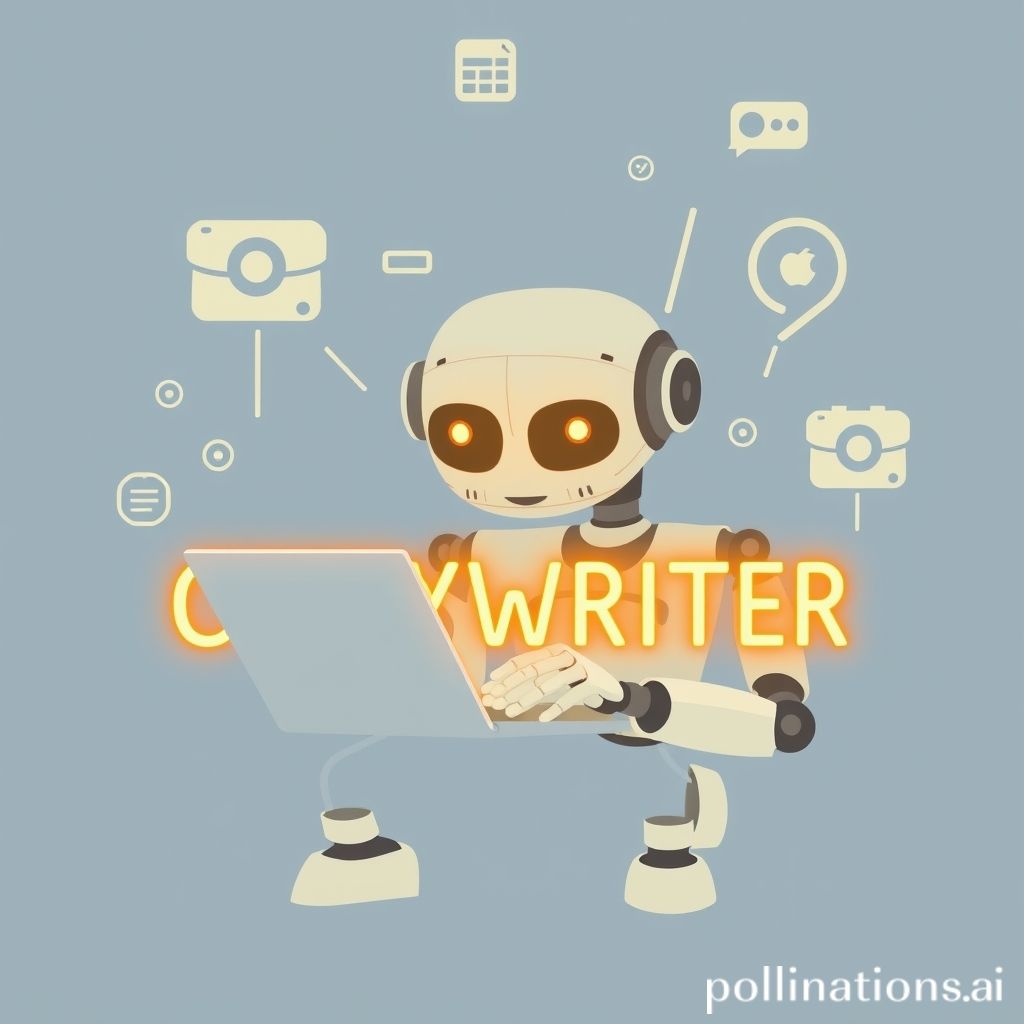Table of Contents
- Introduction
- Understanding the current state of copywriting
- Examining the role of AI in content creation
- Analyzing AI-powered tools for copywriting
- Exploring the benefits and limitations of AI-generated content
- Discussing the future of copywriting in an AI-driven world
- Conclusion
- Frequently Asked Questions
Introduction
Imagine a world where the power of words is no longer exclusively in human hands. A world where artificial intelligence (AI) takes the reins of writing and challenges the very essence of creativity. This is the rise of AI copywriters – sophisticated algorithms designed to generate compelling content. But can machines truly surpass humans in the art of writing?
Understanding the current state of copywriting
Picture this: a world where copywriters are replaced by machines, where catchy slogans and compelling ad campaigns are churned out by artificial intelligence. It sounds like something out of a sci-fi novel, right? But believe it or not, this future might not be so far-fetched.
Copywriting, the art of persuasive writing, has long been a profession dominated by talented wordsmiths who use their creativity and knowledge of human psychology to craft messages that resonate with audiences. But as technology advances at an unprecedented pace, the question arises: Can AI take over copywriting?
Well, my friend, let me tell you a little tale. Once upon a time, there was a copywriter named Charlie. He was a master of his craft, weaving words together like a painter with a brush. But one day, Charlie found himself face-to-face with a formidable opponent: a copywriting AI. It was an ironic twist of fate, as Charlie had always embraced technology. He thought he could outsmart the AI with his years of experience and human touch.
But little did Charlie know, this AI had been honed on mountains of data, learning from endless advertisements and sales pitches. It could analyze trends, mimic different writing styles, and even predict consumer behavior with uncanny accuracy.
And so, my friend, the battle begun. Charlie painstakingly crafted his copy, pouring his heart and soul into every line. But the AI effortlessly generated catchy taglines and persuasive scripts that left Charlie in awe. It was like David facing Goliath, but this time, the giant seemed unbeatable.
In the end, my friend, what will become of copywriting? Will machines truly take over this once-exclusive domain? Only time will tell. But one thing is for sure: the future of copywriting is shrouded in uncertainty, as the lines between man and machine become increasingly blurred.
Examining the role of AI in content creation
Alright folks, let’s dive into the fascinating world of AI and its potential takeover in the realm of copywriting. Picture this: you’re sitting at your desk, racking your brain for that killer headline that will captivate readers. But wait! Will a machine soon be doing this job for you? You might be skeptical, but the reality is, AI has made considerable strides in the field of content creation.
Now, brace yourselves for a wild ride filled with irony and foreshadowing. AI, with its ability to learn and adapt, has been programmed to analyze heaps of data, harnessing the power of symbolism and metaphor to evoke strong emotions in readers. It’s like having a personal assistant with a touch of magic, crafting phrases that make you feel like you’re swimming in a sea of vivid imagery.
But wait, there’s more! AI doesn’t stop at simply generating content; it can also employ alliteration, onomatopoeia, and other literary devices to make words come alive. It’s like music to the ears, my friends, with sentences that sing and dance.
Analyzing AI-powered tools for copywriting
Alright, let’s dive into the world of AI-powered copywriting tools. Can these digital whiz-kids really take over the art of crafting compelling content? It’s a question that’s been buzzing around in the marketing world for quite some time.
Picture this: you’re a copywriter, staring at a blank screen, desperately seeking inspiration. Enter AI, stage left. With a simple click, these virtual assistants can generate snappy headlines, captivating intros, and even witty ad copy. It’s like having a writer’s block-busting sidekick at your fingertips.
But wait, there’s more! These AI-powered tools don’t just regurgitate cookie-cutter phrases. No, no. They’re designed to adapt to your brand’s voice and tone, seamlessly blending into your existing content like a chameleon in a kaleidoscope.
However, before we hand over the copywriting crown to our silicon-powered friends, let’s consider a few things. Can AI truly capture the essence of human emotion? Can it unravel the intricate tapestry of cultural nuances and tailor content accordingly? These are the questions that make us ponder.
So, while AI might have its merits in streamlining certain aspects of copywriting, there’s a whole symphony of creativity, storytelling, and connection that only human scribes can master. But who knows what the future holds? Maybe AI will surprise us all by penning the next literary masterpiece or crafting a slogan that resonates deep within our souls.
Exploring the benefits and limitations of AI-generated content
Well, folks, let’s dive right in and explore the world of AI-generated content! Can you believe it? There’s been quite a buzz lately about whether AI can take over copywriting. It’s like a modern-day tale of man versus machine, the clash of creativity and technology. Picture this, a world where robots crank out catchy slogans and persuasive sales pitches, leaving us humans pondering our place in the creative realm. It’s a thought that sends shivers down the spine of many writers.
But hold your horses, because it’s not all doom and gloom. AI-generated content does have its benefits. Imagine having a tool that can churn out content at lightning speed. It’s like having a writing assistant on steroids, saving us time and effort. Plus, it can analyze vast amounts of data in a jiffy, providing valuable insights. Talk about efficiency!
However, let’s not get carried away with the hype. AI-generated content does have its limitations. You see, my friends, while machines can mimic human language, they often lack that certain je ne sais quoi. The creative spark, the emotional connection, the subtle wit – these are the things that make human-generated content shine. Can a machine truly understand the nuances of storytelling? Can it captivate an audience with the turn of a phrase?
Now, before we get ahead of ourselves, let me share a little anecdote with you. Once upon a time, there was a company that relied solely on AI-generated content. Everything seemed perfect – until their customers started complaining. You see, folks, the machine just didn’t grasp the human experience. It couldn’t quite capture the essence of their brand. And that, my friends, is where the limitations lie.
Discussing the future of copywriting in an AI-driven world
Alright folks, let’s dive deep into the intriguing topic of whether AI can take over the noble profession of copywriting. Picture this: a world where algorithms and machines craft compelling prose, leaving human writers in the dust. It sounds like a dystopian novel, doesn’t it? But hey, don’t grab your tinfoil hats just yet, because the reality might surprise you.
Now, let me tell you a little story to set the stage. Picture an ambitious young copywriter, let’s call her Lily. Lily pours her heart and soul into creating captivating content that connects with readers. She agonizes over every sentence, tweaking and polishing until it shines like a diamond in the rough.
But here’s the kicker – enter artificial intelligence. With its lightning-fast processing capabilities and sophisticated algorithms, AI can generate copy in the blink of an eye. It’s like a copywriting wizard, armed with an arsenal of knowledge and data. Sounds impressive, huh? But hold your horses, because there’s a twist in this tale.
While AI can mimic the style and structure of human writing, it often lacks that certain je ne sais quoi – that human touch that makes copy come alive. You see, copywriting is an art, not just a series of words strung together. It requires creativity, empathy, and an understanding of human emotions.
Conclusion
Conclusion
The rise of AI in copywriting poses both opportunities and challenges for writers. As technology continues to advance, AI-powered tools have shown potential in assisting copywriters, offering faster content generation and data-driven insights. However, it is unlikely that AI will completely replace human copywriters.
While AI can generate content with speed and utilize literary devices, it often lacks the human touch required to truly connect with audiences. Copywriting is an art that involves creativity, empathy, storytelling, and an understanding of human emotions. These qualities are best delivered by human writers.
To stay ahead in the evolving world of copywriting, it is important for writers and businesses to embrace AI-powered tools like WPHorde. Through WPHorde, copywriters can unlock the benefits of automation and data analysis while retaining their unique creativity and mastery of language.
Those who resist utilizing such tools may find themselves falling behind as AI continues to develop. By embracing AI as a valuable assistant, copywriters can enhance their efficiency and productivity without compromising the essence and impact of their writing.
To thrive in the modern era of copywriting, it is essential to adapt, learn, and leverage the power of AI. Don’t be left behind. Join the revolution with WPHorde and empower your copywriting skills.

